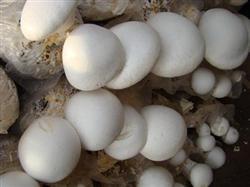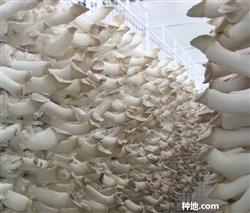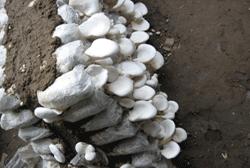Six characteristics of occurrence of diseases and insect pests in Pleurotus ostreatus

The main results are as follows: 1. most of the pathogens and harmful insects in the culture medium are organic matter. For example, rice straw, cottonseed hull and livestock feces themselves carry a large number of germ spores, bacteria, mites, mosquitoes and flies and other eggs: before use, the culture medium needs to be sterilized or fermented to eliminate or reduce the base number of diseases and insect pests and reduce the degree of pain and insect pests. Second, the nutritious cultivation medium provides a good food source for the reproduction of diseases and insects. Many pests and bacteria feed on rotten organic matter, such as jumping insects, mites, gall midges, nematodes, termites and flea flies. After fermentation and ripening, the substrate used for the cultivation of mushrooms, straw mushrooms, Coprinus comatus and Pleurotus ostreatus can give off a unique smell and attract insect adults to lay eggs in the material. In the case of abundant food sources, mites and gall midges can multiply their offspring rapidly in a short time by maternal reproduction, and often break out after 30-40 days. The matured substrate is also the rapid propagation base of competitive miscellaneous bacteria, such as Trichoderma, Rhizopus and Streptomyces spores can propagate rapidly when they fall into the substrate rich in wheat bran, corn meal and cottonseed hulls, while the growth rate of Pleurotus ostreatus inoculated at the same time is slow, and the growth rate of miscellaneous bacteria is much higher than that of Pleurotus ostreatus mycelium. Unsterilized and ripened culture medium, Aspergillus and other miscellaneous bacteria failed to infect, once sterilized and ripened, miscellaneous bacteria multiplied quickly. 3. The suitable environment for mushroom production provides superior conditions for the reproduction of diseases and insects. The temperature of Pleurotus ostreatus is 20: 26 ℃, the temperature of mushroom production is 10: 15 ℃, the water content of culture medium is about 62%, and the air humidity of mushroom place is more than 85%. The suitable environment can accelerate the growth of mycelium and produce mushrooms smoothly. at the same time, it is also suitable for the living conditions of some diseases and insects. Fourth, there is little difference in physiological characteristics between edible fungi and bacteria, and the physiological characteristics are consistent. Many fungicides are easy to harm mycelium and mushroom body, resulting in drug damage. For example, methyl thiophanate and chlorothalonil can easily inhibit the growth of mycelium. Carbendazim could inhibit the mycelium of Pleurotus ostreatus, and the application of dichlorvos led to no emergence or abnormal appearance of Pleurotus ostreatus. Fifth, diseases and insects invade at the same time, cross-infect mushroom mosquitoes and mushroom flies carrying mites and bacteria, and spread viruses, mites and bacteria when they feed and lay eggs on the culture medium and mushroom body, thus infecting the whole environment. Sixth, there is a wide range of diseases and insect pests, and the quantity of reproduction is large. When the fulminant strong pathogenic bacteria were not observed in the early stage, they germinated, grew and propagated in the culture medium, and caused damage once they were found. The mycelium can not be controlled by drugs during the emergence period, some diseases need to be used many times in the mushroom emergence period, and some diseases can not be treated, such as bacterial spot disease and yellow mushroom disease need to be used more than 3 times to control the disease. Mite, gall mosquito and mushroom mosquito can feed on the culture medium, hyphae and mushroom body, and there are insect bodies on the surface and inner layer of the culture medium. Click to get more Pleurotus ostreatus planting technology click to get more edible mushroom planting technology
- Prev

How to cultivate Pleurotus eryngii in North China
How to cultivate Pleurotus eryngii in the north? Please guide Pleurotuseryngii, also known as snow mushroom. Pleurotus eryngii is a kind of large fleshy umbrella fungus with good quality. Pleurotus eryngii has thick seedling meat, crisp and tender texture and delicious taste, which can be called the king of Pleurotus ostreatus. Rich in nutrition, high oligosaccharide content, has the effect of bowel cosmetology. ...
- Next

A New cultivation method of "short breeding" of Pleurotus ostreatus
After the Pleurotus ostreatus bag is full of hyphae, it can not produce mushrooms directly like Pleurotus ostreatus, but only after a post-ripening period of hyphae, which often becomes an insurmountable technical obstacle for many mushroom farmers. According to the characteristics of mycelium, this stage usually takes about 30 to 60 days, and some strains even last as long as 80 days.
Related
- Fuxing push coffee new agricultural production and marketing class: lack of small-scale processing plants
- Jujube rice field leisure farm deep ploughing Yilan for five years to create a space for organic food and play
- Nongyu Farm-A trial of organic papaya for brave women with advanced technology
- Four points for attention in the prevention and control of diseases and insect pests of edible fungi
- How to add nutrient solution to Edible Fungi
- Is there any good way to control edible fungus mites?
- Open Inoculation Technology of Edible Fungi
- Is there any clever way to use fertilizer for edible fungus in winter?
- What agents are used to kill the pathogens of edible fungi in the mushroom shed?
- Rapid drying of Edible Fungi

